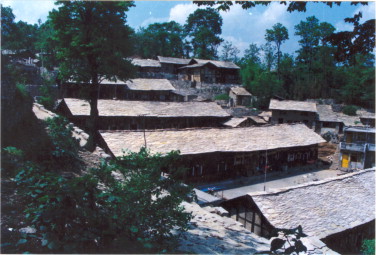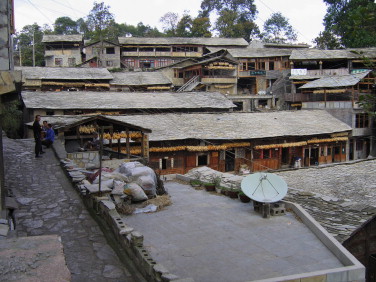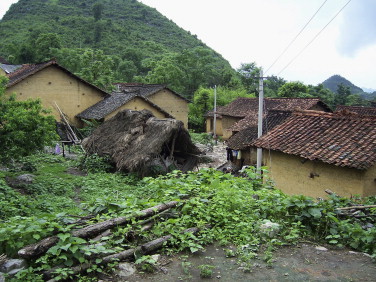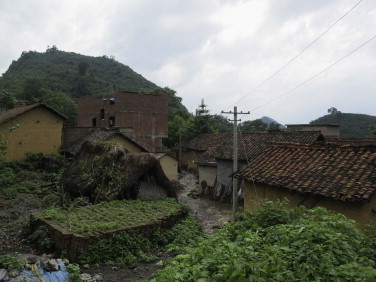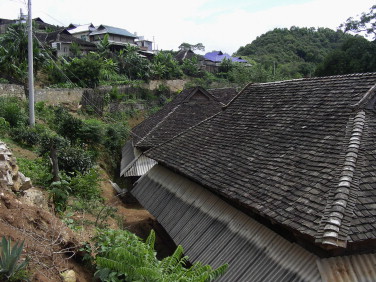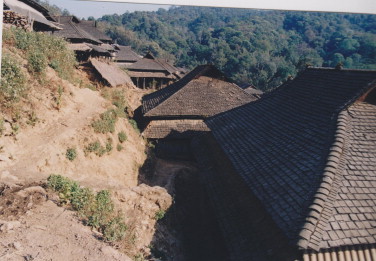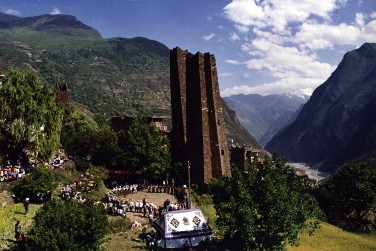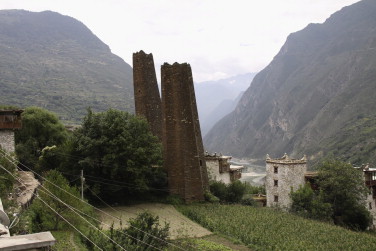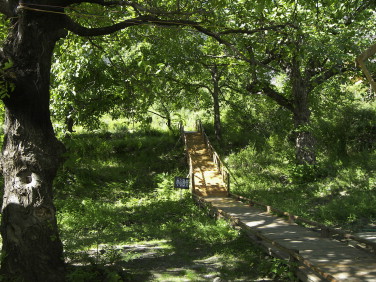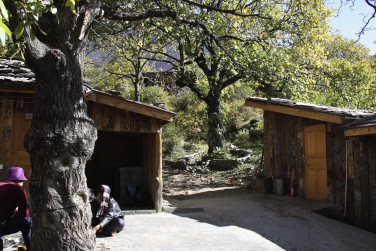Abstract
The environment in villages in Southwest China has been experiencing constant changes, indicating related change-inducing factors as well as their constitution and hierarchy. Starting from the classification of built environment according to Rapoports view, the “environment” consists of fixed, semi-fixed and unfixed elements (A. Fixed-feature elements: infrastructure, buildings, walls, floors, etc. B. Semi-fixed-feature elements: “furnishings” of the environment, interior or exterior, trees and gardens, fences, signs, billboards, lights, etc. C.Unfixed-feature elements: typically people and their activities, behaviors, etc.). Five representative historic villages in Southwest China (Zhenshan Village in Guizhou, Zhanglang Village in Yunnan, Moluo Village in Sichuan, Huaili Village in Guangxi, and Gongzhong Village in Tibet) were investigated to demonstrate the changes in terms of landscape in the last decade. This article provides an analysis of the dialectical relationship between reservation practices and evolving landscapes from a diachronic perspective. This analysis reveals defects of heritage conservation projects for historic villages in Southwest China. The results indicate the following: (1) there exists an important relationship between unfixed-feature elements of landscape and cultural heritages in historic villages; (2) semi-fixed-feature elements, although being neglected in most preservation practices, show strong sensitivity to mass tourism; (3) fixed-feature elements are highly vulnerable to civil engineering techniques; and (4) the most active change-inducing factors for evolving landscapes in historic villages include value orientations of villagers, relative locations of villages, ethnic groups, customs, and economic development. In conclusion, approaches to promoting sustainable development of historic village in Southwest China are explored.
Keywords
Historic villages ; Built environment ; Evolving landscape ; Cultural heritage ; Southwest China
1. Introduction
In the past decade, rapid urbanization in China was paralleled with the contradiction between economic growth and heritage conservation in historic villages (Fu and Wand, 2006 ; Li, 2010 ; Yu, 2006a ). There are increasing concerns in research, media, and government reports about the growing number of tourists in these villages. The issue of conservation has been mainly regarded as an instrument influencing the under-developed regions, particularly in Southwest China, including Sichuan and Guizhou Provinces, Guangxi Zhuang Autonomous Region, Yunnan Province, and Tibetan Autonomous Region, where mixed settlements of Han and other minority ethnic groups are commonly observed. Therefore, in order to understand the above phenomenon, the research shall be extended beyond the aspect of urbanization and in relation to landscape transition and related change-inducing factors. Existing literature on historic villages in Southwest China is concentrated on economic development and the importance of preservation (Li, 2004 ; Li, 2010 ). Although the issue of conservation of historic villages in Southwest China at large has entered researchers' attention (Yu, 2006b ), the topics of evolving landscapes as well as landscape transition remain under-researched.
The environment in villages in Southwest China has been experiencing constant changes, indicating related change-inducing factors as well as their constitution and hierarchy (Yu, 2006a ; Yu, 2009 ). The concept of “landscape transition” is proposed to examine the origin of the contradiction between development and conservation of historic villages from the perspective of landscape change. Starting from the classification of built environment according to Rapoports view, the “environment” consists of fixed, semi-fixed and unfixed-feature elements (Rapoport, 1988 ; Rapoport, 1990 ). Five representative historic villages in Southwest China were investigated to demonstrate the changes in terms of landscape in the last decade. An analysis of the dialectical relationship between reservation practices and evolving landscapes is provided from a diachronic perspective. In particular, the origin of evolving landscapes in historic villages is traced and the most sensitive factors that could facilitate the implementation of preservation practices are explored.
Five historic villages were chosen from five provinces in Southwest China as representative case studies, taking such characteristics of these villages as conservation status, landscape value, residents ethnicity, orientations, and the relative locations to the adjacent big city into consideration. These five villages are Zhenshan Village in Guizhou Province, Zhanglang Village in Yunnan Province, Moluo Village in Sichuan Province, Huaili Village in Guangxi Zhuang Autonomous Region, and Gongzhong Village in Tibetan Autonomous Region. Their basic features are shown in Table 1 .
| Village | Location | Ethnicity | Age | Conservation Status |
|---|---|---|---|---|
| Zhenshan Village | Guizhou Province | Buyi | 400 | Guizhou heritage conservation unit Ecomuseum Guizhou historic and cultural village |
| Huaili Village | Guangxi Zhuang Autonomous Region | Yao | 300 | Ecomuseum |
| Zhanglang Village | Yunnan Province | Bulang | 1000 | Ecomuseum |
| Moluo Village | Sichuan Province | Zang | 400 | Chinese historic and cultural village |
| Gongzhong Village | Tibetan Autonomous Region | Zang | 300 | The best traditional village in Tibet |
2. Landscape classification system of historic villages in Southwest China
2.1. Rapoports concept on built environment
Rapoport, 1981 ; Rapoport, 1990 defines the concept of built environment as a location in which a certain set of activities take place. Based on the characteristics first proposed by Hall (1966) , Rapoport classifies the features of built environment into three types: fixed-feature, semi-fixed-feature and unfixed-feature elements. Fixed-feature elements are defined as basically fixed or those that change rarely and slowly, such as infrastructure, buildings, walls, floors, and others. Semi-fixed-feature elements are variable, such as “furnishings” of the environment, interior or exterior, trees and gardens, fences, signs, billboards, lights, etc. Unfixed-feature elements are non-environmental, behavioral cues that typically include people and their activities and behaviors, among others (Table 2 ).
| Types of Elements | Features | Landscape items |
|---|---|---|
| Fixed-feature elements | Village framework | Surrounding terrain; texture of the whole village |
| Architecture | Dwellings; public buildings; auxiliary buildings | |
| Roads and squares | Streets, footpaths, squares, and other under-developed spaces | |
| Landmarks and logos | Main entrance; defense structures; wells for drinking water; logo structures | |
| Semi-fixed-feature elements | Interior settings | Layout of dwellings; living area for family members; connections between indoor and outdoor spaces |
| Traditional finery and headdress | Dress and headdress, especially when people dress up | |
| Instruments | Various indigenous instruments used by the villagers in different ethnic groups | |
| Hand-made appliances | Appliances for daily life; dressmaking, farming | |
| Plants | Crops; forests; old trees | |
| Unfixed-feature elements | Daily lifestyle | Behavior of a normal villager, such as dressing up, farm work, communication |
| Festival celebrations | The way villagers celebrate festivals; the scale and scope of festivals | |
| Weddings | The way marriages are matched; the way young people communicate, and weddings | |
| Funerals | Rituals and beliefs concerning death | |
| Rituals | Sacrifices of prayers to gods for good weather, agricultural harvest, peace and safety | |
| Oral inheritance | The way villagers orally learn special skills; the history of their ancestors; village traditions |
Given its application to similar researches beyond China, Rapoports (1990) classification system of built environment is adopted in the study of historic village landscape in Southwest China. As a kind of complex built environment, the landscape in historic villages remains under-researched in terms of its classification system. The past decade witnessed the shift of the research focus on historic villages from single building to historic areas, and then to the entire villages. However, no universally recognized model was identified. Architectural researchers are accustomed to the classification of landscape according to its particular characteristics, which are described as vernacular dwellings, outdoor spaces, traffic spaces, etc. However, heritage researchers often describe the village landscape as tangible heritage, cultural spaces, and manifestation of traditions. The differentiations among these concepts indicate that the classification of landscape is an essential precondition for study. In other words, the investigation on landscape of these villages is difficult without an appropriate classification. Therefore, Rapoports classification system is applied to facilitate in-depth landscape analysis. Previous application of this classification system in the examination of village ecomuseums in Guizhou Province showed satisfactory results (Yu, 2006b ).
2.2. Classification system of landscape in historic villages in Southwest China
Following Rapoport, 1981 ; Rapoport, 1990 , this article reorganizes the landscapes of historic villages in Southwest China according to several characteristics, as shown below.
3. Investigation of landscape transition in the five villages in the last decade
As shown in Table 4 , generally speaking, the last decade witnessed significant changes in the fixed-feature landscape in the five sample villages. The greatest changes occurred in Gongzhong, where three fixed-feature elements showing high level of changes. Zhenshan and Zhanglang are in the next place, showing one item being significantly changed. The original features of the remaining two villages have been maintained to a certain extent. For individual items of the fixed-feature elements, the degree of changes varied from high to low according to the following sequence: architecture, framework, roads and squares, and landmarks.
| Villages | Historical pictures | Latest pictures |
|---|---|---|
| Zhenshan |
1995 |
2010 |
| Huaili |
2004 |
2010 |
| Zhanglang |
2005 |
2010 |
| Moluo |
2004 |
2010 |
| Gongzhong |
2005 |
2010 |
| Village | Degree of changes of fixed-feature elements | Influencing level of inducing factors | |||||
|---|---|---|---|---|---|---|---|
| Framework | Architecture | Roads and squares | Landmarks | Preservation status | Transportation | Tourism | |
| Zhenshan | ☆☆ | ☆☆☆☆ | ☆☆ | ☆ | High | Low | High |
| Huaili | ☆ | ☆ | ☆ | ☆ | High | Medium | Medium |
| Zhanglang | ☆☆ | ☆☆☆☆ | ☆ | ☆ | High | Medium | High |
| Moluo | ☆ | ☆☆ | ☆ | ☆ | High | High | High |
| Gongzhong | ☆☆☆☆ | ☆☆☆☆ | ☆☆☆ | ☆ | Medium | High | High |
Note: The number of ☆ represents the degree of changes.
The changes of architectural features are obvious in three villages, whereas the other two villages experienced changes in terms of architecture to much lesser degree. Landmark changes are the least for all the five cases. Changes in terms of framework as well as roads and squares are shown to a medium extent.
According to relevant analysis, three inducing factors (i.e., preservation status, transportation and tourism) are the most relevant parameters to the evolving landscapes of these historic villages. The correlation between these inducing factors and all kinds of fixed-feature elements are investigated separately, as in the case of semi-fixed-feature and unfixed-feature landscape of these villages. In Zhenshan and Zhanglang Villages, high correlations between fixed-feature landscape transition and inducing factors of preservation status and tourism are recorded, while low correlations with inducing factor of transportation are reported. In Huaili and Gongzhong Villages, high correlation with preservation status and low correlativity with transportation and tourism are indicated.
No significant framework change is recorded in most villages, except for the case of Gongzhong Village. The framework element of Gongzhong Village changed significantly due to the improvement of transportation outside the village. The other four villages maintained their frameworks to a certain degree. Changes were manifested in ascending density and scale, extended boundaries and reduced public spaces.
For the fixed-feature landscape, the aspect that experienced the greatest changes in terms of architecture among these case villages is the transition of dwellings. In the last decade, half of these villages experienced visible changes in buildings, especially in Zhenshan Village, the most typical village. One of the possible reasons could be attributed to the location of Zhenshan that is approximate to the city of Guiyang, thereby potentially influencing the process of urbanization. However, since the village is located between a lake and a mountain, its hidden terrain helps maintaining the unique characteristics of the landscape. Therefore, the village was less vulnerable to economic and tourism factors. As shown in Table 3 , the site layout of the village in 2010 differed significantly from that in 1995, especially in terms of ascending quantity and density of buildings. The inducing factors are investigated from two aspects: on the one hand, they are examined from the perspective of extended family of villagers; on the other hand, they are explored in terms of demand of tourists. In order to provide accommodations, villagers retrofitted their dwellings according to vernacular style with regard to facade, orientation, layout, and material.
Roads and squares are experiencing slow changes in these case villages. In most villages, the changes in terms of roads and squares are manifested in the functions of spaces. Some of the squares that previously used for public gatherings and traditional activities are shifted to transportation purpose. Some of the footpaths were widened and improved using materials that are more durable.
Such features as landmarks and logos show least changes in the five case villages since landmarks are always the focuses in conservation practices, as well as emblems of lifestyles of villagers. It is necessary to maintain traditional characteristics such as landmarks for the villages, both from inside and outside.
It can be seen from Table 5 that the last decade experienced an obvious tendency of change in terms of semi-fixed-feature landscape in all five case villages. The degree of changes for 60% of the items of the semi-fixed-feature elements reaches the level of four stars. The greatest changes occurred in Zhenshan, with 80% of items of landscape features experienced significant changes. Gongzhong and Zhanglang are in the next place, with 50% of their items being significantly changed. The original features of the remaining two villages are maintained to a certain extent. For individual items of the semi-fixed-feature elements, the degree of changes varied from high to low in the following sequence: finery and headdress, handmade appliances, instruments, interior setting, and plants.
| Village | Degree of changes of semi-fixed-feature elements | Influencing level of inducing factors | ||||||
|---|---|---|---|---|---|---|---|---|
| Interior setting | Finery and headdress | Instruments | Handmade appliances | Plants | Conservation status | Transportation | Tourism | |
| Zhenshan | ☆☆☆ | ☆☆☆☆ | ☆☆☆ | ☆☆☆☆ | ☆☆ | High | Medium | High |
| Huaili | ☆ | ☆ | ☆☆ | ☆ | ☆ | High | Low | Low |
| Zhanglang | ☆☆☆ | ☆☆☆☆ | ☆☆☆ | ☆☆☆ | ☆ | High | Medium | High |
| Moluo | ☆☆ | ☆☆☆ | ☆☆ | ☆ | ☆ | High | High | Medium |
| Gongzhong | ☆☆☆☆ | ☆☆☆ | ☆☆☆ | ☆☆☆☆ | ☆☆ | low | Medium | High |
Note: The number of ☆ represents the degree of change.
In the cases of Zhenshan and Zhanglang Villages, high correlation between semi-fixed-feature landscape transition and the inducing factors of preservation status and tourism is reported, whereas medium correlation with the inducing factor of transportation is noted. For Huaili Village, high correlation with the inducing factor of preservation status and low correlation with transportation and tourism are recorded. As for Moluo Village, high correlations with the inducing factors of preservation status and transportation and medium correlations with the inducing factor of tourism are observed. In the case of Gongzhong Village, high correlations with the inducing factor of tourism, medium correlations with transportation and low correlations with preservation status are reported.
It can be seen that the interior settings of vernacular dwellings in the five case villages changed significantly, in parallel to the retrofitting in order to accommodate modern lifestyles or tourism business. Villagers in most villages have shifted from traditional furnishings to modern living facilities. Even the fireplaces are vanishing, which had been regarded as the center for communal activities. The daily lifestyle of villagers changed as well (details will be discussed below).
It is reported that great changes emerged in terms of finery and headdress in five case villages. People who would like to dress in a traditional style have lessened since 2000. In 2005, however, in some of the case villages, such as Zhenshan and Zhanglang, more people were observed to dress in traditional clothes, which possibly highly related to tourism.
Although the appearance of instruments did not change much, their quantity, frequency and occasion of application, and functions changed to some extent. Traditionally, villagers use these instruments for festivals, weddings and funerals, and to communicate with each other. In the last decade, the frequency of use of these instruments increased, whereas the occasions and functions of their application extended to exhibit the ethnic customs.
In the five case villages, it is reported that the changes in terms of handmade appliances varied. In villages with a developing tourism industry, appliances changed markedly. However, in other cases, they remained intact.
Plants, as a necessary source of food and clothing material as well as maintaining the quality of environment, remained unaffected for a long time, perhaps due to the belief of original ecology and primitive adoration of old trees.
From Table 6 , it can be observed that the last decade experienced a varied tendency of change for the unfixed-feature landscape in the five case villages. However, unlike other elements of landscape, two items sustained in their traditional forms: funerals and rituals. Some items changed significantly, such as daily lifestyle, weddings and oral culture. However, festivals are reported to change at a medium level. The degree of changes varied from high to low in the following sequence: daily lifestyle, oral inheritance, weddings, festivals, funerals, and rituals.
| Villages | Degree of changes of unfixed-feature elements | Influencing level of inducing factors | |||||||
|---|---|---|---|---|---|---|---|---|---|
| Daily lifestyle | Festivals | Weddings | Funerals | Rituals | Oral inheritance | Conservation status | Transportation | Tourism | |
| Zhenshan | ☆☆☆☆ | ☆☆ | ☆☆☆ | ☆ | ☆ | ☆☆☆ | Medium | High | High |
| Huaili | ☆ | ☆ | ☆ | ☆ | ☆ | ☆☆ | High | Medium | Low |
| Zhanglang | ☆☆☆ | ☆☆ | ☆☆☆ | ☆ | ☆ | ☆☆☆ | High | Medium | High |
| Moluo | ☆☆ | ☆☆ | ☆☆ | ☆ | ☆ | ☆☆ | Medium | Medium | Medium |
| Gongzhong | ☆☆☆☆ | ☆☆ | ☆☆ | ☆ | ☆ | ☆☆☆ | Medium | High | High |
Note: The number of ☆ represents the degree of change.
As for Zhenshan and Gongzhong Villages, high correlations between unfixed-feature landscape transition and the inducing factors of transportation and tourism are observed, and medium correlation with transition and preservation status are reported. In the case of Huaili Village, high correlations with the inducing factors of transition and preservation status, medium correlation with transportation, and low correlation with tourism are shown. For Zhanglang Village, high correlations with the inducing factors of preservation status and tourism, and medium correlation with the inducing factor of transportation are noted. For Moluo Village, medium correlations with all the inducing factors of preservation status, transportation and tourism are reported.
All five case villages are reported to experience significant changes in terms of daily lifestyle, most likely due to the development of modern life. In some villages, such as Zhenshan and Gongzhong, villagers make livings not only through agriculture but also by means of tourism. Villagers now dress up in traditional clothes with embroidery and use handmade appliances less frequently compared to the past time.
It is observed that weddings are becoming more and more simplified at large in the five case villages. On the one hand, in terms of marriage matching, young villagers look for partners in wider areas, despite the fact that a mate of the same ethnicity was more favored in a traditional perspective. On the other hand, weddings, that had been complicated, are now more simplified, and westernized as well. Villages, including Huaili, changed slowly because of their under-developed economy and transportation.
Funerals, as one of the items of unfixed-feature landscape that experienced least changes, are still conducted in a traditional way. Funeral activities are not simplified, though. However, such events are not accessible to tourists.
Rituals, as the other item that experienced less change, have remained intact for a long time. Mysteries are the sources of the rituals. Important members of the village play key roles in all kinds of rituals.
Since 1980s, oral inheritance has experienced the tendency of diminishing. In the last decade, however, more attention was paid to oral inheritance in primary schools as a means of preserving intangible heritages. Support projects were carried out in villages that are built into ecomuseums. However, in some villages, there is a lack of “oral culture inheritors,” that are designated by government and cultural organizations and responsible for learning the endangered oral traditions and teaching others, especially young people.
4. Conclusion and prospect
In the past decade, significant changes occurred in historic villages in Southwest China, which were induced by varied factors. The degree of changes shows the following sequence from high to low: fixed-feature, semi-fixed-feature and unfixed-feature elements. However, based on relativity between landscape changes and preservation practices, the degree of changes varied according to the following sequence: fixed-feature, unfixed-feature and semi-fixed-feature elements. Therefore, we propose that focus be placed on semi-fixed-feature elements, and an in-depth investigation on landscape transition be conducted in order to identify specific measures of conservation. In these historic villages, there exists an important relationship between unfixed-feature elements and cultural heritages. Semi-fixed-feature elements, which have been neglected in most preservation practices, show strong sensitivity to mass tourism. Fixed-feature elements of landscape can be vulnerable to civil engineering techniques. The most active change-inducing factors for evolving landscapes in historic villages include value orientation of villagers, relative locations of villages, ethnic groups, customs, and economic development.
Finally, in order to promote sustainable development of historic villages in Southwest China, the following measures shall be taken in preservation practices: (1) strict restraints prohibitions on adverse changes for the low-carbon landscape; (2) more attentions on the regeneration of vernacular dwellings by means of advanced technology; and (3) in-depth explorations on cultural spaces in relation to intangible heritages.
References
- Fu and Wand, 2006 Y. Fu, D. Wand; The inheriting of folk handicrafts in southwestern minority nationality regions; Guizhou Ethnic Studies, 2006 (1) (2006), pp. 41–45
- Hall, 1966 E.T. Hall; The hidden dimension; Doubleday & Company, New York (1966)
- Li, 2004 S. Li; Retrospection and prospects for studies of southwestern nations; Guizhou Ethnic Studies, 2004 (3) (2004), pp. 50–55
- Li, 2010 J. Li; From vernacular dwelling to settlement: new trend of study on chinese regional culture of architecture: taking the southwest area as example; Architectural Journal, 2010 (3) (2010), pp. 82–84
- Rapoport, 1981 A. Rapoport; Identity and environment: a cross-cultural perspective; J.S. Duncan (Ed.), Housing and Identity: Cross-cultural perspectives, Croom Helm, London (1981), pp. 6–35
- Rapoport, 1988 A. Rapoport; Levels of meaning in the built environment; F. Poyatos (Ed.), Cross-Cultural Perspectives in Nonverbal Communication, C.J. Hogrefe, Toronto (1988), pp. 317–336
- Rapoport, 1990 A. Rapoport; The Meaning of the Built Environment; (second edition)University of Arizona Press, Tucson (1990)
- Yu, 2006a Yu, Y., 2006a. On application of ecomuseum theory to landscape protection — Illustrated by the heritage protection of rural village landscape in southwest China [D]. Southeast University of China (in Chinese).
- Yu, 2006b Y. Yu; On the Value Orientation of Rural Village Landscape and Its Protection and Utilizing Way; Journal of Chinese Landscape Architecture, 2006 (1) (2006), pp. 66–68
- Yu, 2009 Y. Yu; Action and retrospection:protection and evolution of landscape of zhenshan village; South Architecture, 2009 (4) (2009), pp. 42–48
Document information
Published on 12/05/17
Submitted on 12/05/17
Licence: Other
Share this document
Keywords
claim authorship
Are you one of the authors of this document?
